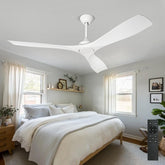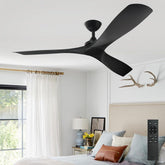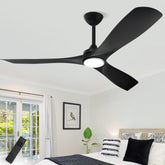The Evolution of the Ceiling Fan: A Comprehensive Guide
Photo by Depuley
Ceiling fans have been a popular addition to homes and other spaces for centuries. They offer both decorative value and practical functionality, particularly in hot weather. With their ability to circulate air effectively, these fans provide a reliable solution for keeping rooms cool and comfortable.
In this guide, we will explore the history of ceiling fans, their evolution, and how they have become an essential part of modern living.
What is a Ceiling Fan?
A ceiling fan is a mechanical device that is people typically mount on the ceiling of a room or space. Its primary function is to circulate air and create a cooling effect. The fan consists of several key components, including a motor, blades, and a housing.
The motor of a ceiling fan, commonly housed within the unit, is responsible for its operation and power supply. While electric motors are the most prevalent type, other energy sources like solar power or batteries can also be utilized to drive the fan's motor.
The blades of a ceiling fan attach to the motor and actively rotate when the motor is activated.They are typically crafted from lightweight materials such as wood, plastic, or metal. The number and shape of the blades can vary, with most ceiling fans having three to five blades. The blades are strategically angled to create airflow and move the air in the room.
The housing of a ceiling fan encloses the motor and provides support for the blades. Manufacturers typically construct it from metal or plastic materials. It is usually made of metal or plastic. Its design aims to be aesthetically pleasing while also ensuring the safety and stability of the fan. The housing may also include additional features such as a light fixture or a remote control receiver.
When turned on, the ceiling fan's motor spins the blades, generating a downward airflow.This airflow creates a wind-chill effect, which helps to evaporate moisture from the skin, making the room feel cooler. Apart from their cooling capabilities,they serve a vital role in enhancing air circulation and ventilation within a room. This not only aids in distributing heat during the winter months but also helps to alleviate humidity levels during the summer season.
Ceiling fans are commonly found in residential homes, offices, hotels, and other commercial spaces. They are available in a wide range of styles, sizes, and finishes to suit different interior designs and personal preferences. Some ceiling fans also come with additional features such as adjustable speeds, reversible blades for different seasons, and built-in lighting.
In summary, a ceiling fan is a versatile and practical device that is suspended from the ceiling and designed to circulate air in a room or space. It consists of a motor, blades, and a housing, all working together to create a cooling effect and improve air circulation. Ceiling fans, with their diverse designs and functionalities. Have gained popularity for improve comfort and energy conservation in both homes and business environment. They can be controlled through a pull chain, a wall-mounted switch, or remote control.
The History of the Ceiling Fan
Ceiling fans have a fascinating place in history, with origins dating back to ancient times. The earliest known form of a fan was the palm leaf fan used by the Egyptians around 4,000 BC. These fans were made of palm leaves and were manually operated by servants to keep their masters cool.
The invention of the first ceiling fan in India did not occur until the 17th century.The punkah, an ingenious fan-like contraption, was ingeniously fashioned from palm leaves or cloth and elegantly suspended from the ceiling.
They were moved manually by a servant pulling a cord to turn the palms and move the air. Around the year 1860, the United States witnessed the installation of its initial ceiling fan. However, unlike modern fans powered by electricity, this early iteration relied on a belt system and harnessed water or steam energy as its driving force.
The belt-driven mechanism of these fans enabled the installation of a comprehensive network throughout vast buildings, resulting in their widespread popularity among offices, department stores, and even restaurants. This efficient setup allowed for effective air circulation on a larger scale, catering to the comfort and satisfaction of patrons and employees alike.
In 1882, Philip Diehl, an employee of the Singer sewing machine company, revolutionized fan technology by inventing an electric ceiling-mounted fan. Utilizing a sewing machine motor as its power source, this invention marked a significant milestone in the evolution of fans. To further enhance its functionality, Diehl later incorporated a light component into the design, making it a versatile and practical investment.
With advancements such as additional fan blades, energy-efficient technologies, and insights from aerodynamic sciences over time, ceiling fan sales experienced continuous growth worldwide. In the late 20th century, this trend resurged within the United States market once again.
Why Use a Ceiling Fan?
Ceiling fans are beneficial for many reasons. They offer a cost-effective alternative to air conditioners, particularly with the advent of new models featuring energy-efficient DC motors. Equipped with a light component, they serve multiple purposes within a space. The ease of use is enhanced by the availability of wireless remote controllers for many ceiling fan models.
In addition to their convenience, A fans provide an added benefit during colder months. By utilizing the directional change switch, they can effectively circulate warm air downwards, leading to potential savings on heating expenses. Furthermore, these fans operate quietly and are often utilized as a source of soothing white noise that aids in promoting restful sleep for individuals and children alike.
Choosing the Right Ceiling Fan
When choosing a ceiling fan, there are several factors to consider. The size of the room will determine the size of the fan needed.
A fan that is too small for a room will not provide adequate circulation, while a fan that is too large can be overpowering. Energy-efficient ceiling fans are also a great option to save on energy costs. When choosing a ceiling fan with lights, make sure the fixture is rated for the size of the fan and that it provides adequate lighting for the room.
Popular Trends in Ceiling Fans
Ceiling fans have come a long way since their invention in the 17th century. Today, there are many different styles and designs to choose from, including modern, traditional, and tropical. One of the most popular trends in ceiling fans is the use of LED lights.
LED lights are renowned for their energy efficiency and extended lifespan, making them an excellent choice for individuals seeking to reduce energy expenses. Their remarkable longevity coupled with their ability to consume less power make LED lights a highly advantageous option in terms of cost savings and sustainability.
Another popular trend is the use of remote controls for ceiling fans. Remote controls make it easy to adjust the speed and lighting of the fan from anywhere in the room. Some ceiling fans even come equipped with smart technology, allowing them to be controlled by a smartphone app or virtual assistant.
Conclusion
Ceiling fans have a rich history and have come a long way from their humble beginnings. They have become a crucial element of contemporary living, serving as a practical solution for maintaining comfort during hot weather. Additionally, these fans contribute to the room's decor, adding an aesthetic touch to the overall ambiance.
When choosing a ceiling fan, it is important to consider the size of the room, energy efficiency, and other factors to ensure the right fit. With so many styles and designs to choose from, there is a ceiling fan for every taste and budget. At Depuley we offer a wide range of ceiling fans to suit any home or office decor. Choose a ceiling fan today and experience the benefits of this essential appliance.














